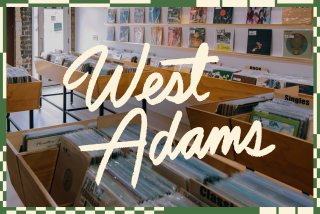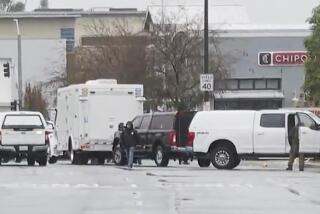Remember the Main Attractions of Old Tustin
- Share via
You can take Main Street to history with a walking tour of old Tustin. Start at the Knights of Pythias building, now home to the Tustin Area Museum, where even the staff has made history. High tea and other delights are offered at McCharles House, built in 1885. Nearby mercantiles and domiciles are perfect for a post-prandial meander.
11:30 to noon: Exhibits at the Tustin Area Museum include red rocks from Red Hill (which is a 347-foot-high mound of cinnabar) and the head of a bear killed in Trabuco Canyon by a Native American whose grandson gave it to local taxidermist Charles Cleary.
Hanging on the walls are track shoes worn by Evelyn Furtsch Ojeda while training at Tustin Union High School (she won a gold medal in the 100-meter relay at the 1932 Olympics) and a photograph of F.W. Garlock’s Grocery Store, located in New Delhi--a community “around the sugar beet area” of what is now Santa Ana.
Amid so much nostalgia there’s also a corrective exhibit called “The Good Old Days?”
An early electric iron is described as “truly modern”--it came with a convenient metal carrying case--but the Modern Gasoline-Gas Iron, while “not foolproof,” was “positively the best iron of its kind in use today.” The instructions that came with the gas iron may be one reason it went the way of oblivion: “If results are not right, look at directions and see what you have done that is wrong. Errors can never be the fault of the iron.”
Photos of pioneers include Columbus Tustin, who with N.O. Stafford bought 1,359 acres on which to establish Tustin City in 1868. Tustin converted a 1912 Buick into the area’s first firetruck; today it’s the museum’s centerpiece. Nearby, the front half of a police car seems to be coming through the wall--yup, broken and entering. “The Police Department kind of wanted equal time in here, but we didn’t have room for the whole thing,” explained the museum manager, Evelyn Ojeda. Wait a minute . . . Ojeda? Any relation to the track star?
“That’s me!” she said.
For sale are 12 volumes of “Pioneer Memories of the Santa Ana Valley,” and “Tustin Tintypes,” a pictorial history. Not for sale are “The Hayburners of Orange County,” “From Jennies to Jets,” and “SAAAB Story,” a history of the Santa Ana Army Air Base.
The museum offers a free walking tour brochure and map. A more detailed “Tustin Heritage Walk” ($2.50) was published in 1974, but many trees and houses it describes are now gone. “It’s disappointing,” said Carol Jordan, local historian and a museum founder. “But I understand that not everything can be saved, nor should everything be saved. It’s nice that we have Main Street pretty well intact.”
Noon to 1:15: The McCharles House was built by D.L. McCharles, a carpenter and later Tustin’s township justice. The Heredia family purchased the home in 1980 and, after adding paisley fabrics and cabbage rose wall coverings, opened the restaurant five years later. Today, the wall coverings, tablecloths, rugs, dishes and the dresses of the women lunching at McCharles House add up to a dizzying array of patterns. Imagine Laura Ashley on LSD.
Nine Teas of the Nineties ($9 to $19) are each registered trademarks. Among them are a Polo Tea that comes with macaroni and cheese and apple chutney; Chocolatea Tea with chocolate chunk scone, chocolate fruit and nuts, and chocolate dessert; Animal Cracker Tea with peanut butter-and-jelly sandwiches on graham crackers and an ice-cream scone, and Cabbage Rose Tea--cabbage rolls offset by a “ruby garnet salad” of purple cabbage, marinated beets and purple onions.
A scone, alone, is $1.50; a pot of hot water and tea service is $2.50. The atmosphere may be genteel, but don’t be fooled: There’s nothing dainty about the portions at these teas, and after a dessert of traditional bread pudding with whipping cream ($6), a walking excursion is definitely in order. (The restaurant is closed this Saturday for the holiday.)
1:15 to 2:30: Highlights of the heritage walk include the Stevens House (228 W. Main St.), a Queen Anne Victorian home complete with multifaceted gabled roofs, and the Vance House (420 W. Main), which has fish-scale siding and spindle balusters; both date to 1887. Residents of the Hewes House built in 1881 (350 South B St.) included Count Jaro von Schmidt, who hired boys to kill hummingbirds that he then stuffed for ladies’ hats.
The frontier-style building at 434 El Camino Real was built for Tustin’s first doctor; a plaque near 130 W. Main St. marks the 1870 site of the stagecoach stop, and the Tustin Blacksmith Shop at 245 South C St. is one of two such establishments remaining in the county.
Heading east along Main Street is a sign that says, “For lease, your place in history.” Its history already firmly established, McCoy Sheet Metal Works has been at 160 E. Main since 1928. Heading any farther east will add distance but relatively little history: At the easternmost point of the official tour is the recently refurbished Tustin Civic Center, built in 1974 and described even then as “functional, accessible (and) inexpensive.”
3-Hour Tour
1. Tustin Area Museum
397 El Camino Real
(714) 731-5701
Open Tuesday and Thursday, 9 a.m. to 2 p.m., and first Saturday of the month, 10 a.m. to 3 p.m.
2. McCharles House
335 South C St.
(714) 731-4063
Open Tuesday and Wednesday, 11:30 a.m. to 5 p.m.; Thursday through Saturday, 11:30 a.m. to 5 p.m. and 5:30 to 8 p.m.
3. Tustin Historic District Walking Tour
Starting point at Main and C streets
(714) 731-5701
Free brochure with map at Tustin Area Museum.
Parking / Buses
Parking: Structure just south of Main Street on C Street.
Buses: OCTA buses 71 and 65 run east and west along 1st Street with a stop at El Camino Real. Bus 66 runs north and south along El Camino Real.
More to Read
Sign up for The Wild
We’ll help you find the best places to hike, bike and run, as well as the perfect silent spots for meditation and yoga.
You may occasionally receive promotional content from the Los Angeles Times.






